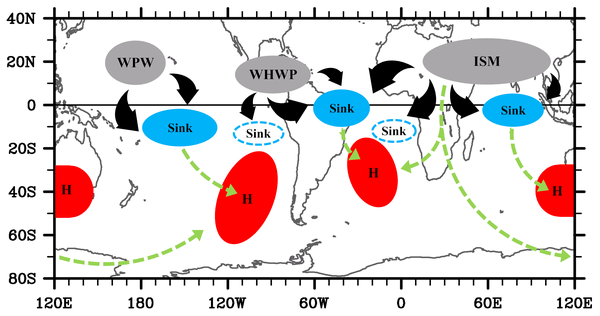by Sang-Ki Lee et al.
In a recent article accepted for publication in the Journal of Climate, scientists in PhOD, S.-K. Lee (CIMAS) and C. Wang collaborated with R. Mechoso and D. Neelin, both at UCLA, to explore why the southern subtropical anticyclones are notably stronger in the austral winter than in summer, which is in contrast with the Northern Hemisphere (NH) in which subtropical anticyclones are more intense in summer according to the monsoon heating paradigm. They performed model experiments to show that during the boreal summer enhanced tr

opical convection activity in the NH plays important roles in strengthening the southern subtropical anticyclones.
The southern subtropical anticyclones are notably stronger in the austral winter than in summer, particularly over the Atlantic and Indian Ocean basins. This is in contrast with the Northern Hemisphere (NH), in which subtropical anticyclones are more intense in summer according to the “monsoon heating” paradigm. To better understand the winter intensification of southern subtropical anticyclones, the present study explores the interhemispheric response to monsoon heating in the NH during the austral winter. A specially designed suite of numerical model experiments is performed in which summer monsoons in the NH are artificially weakened. These experiments are performed with both an atmospheric general circulation model and a simple two-layer model. The highlight of our findings is that during the boreal summer enhanced tropical convection activity in the NH plays important roles in either maintaining or strengthening the southern subtropical anticyclones. Enhanced NH convection largely associated with the major summer monsoons produces subsidence over the equatorial oceans and the tropical Southern Hemisphere via interhemispheric meridional overturning circulations and increases the sea level pressure locally. In addition, suppressed convection over some regions of climatological subsidence produces stationary barotropic Rossby waves that propagate far beyond the tropics. These stationary barotropic Rossby waves and those forced directly by the summer heating in the NH are spatially phased to strengthen the southern subtropical anticyclones over all three oceans. The interhemispheric response to the NH summer monsoons is most dramatic in the South Pacific, where the subtropical anticyclone nearly disappears in the austral winter without the influence from the NH.
Lee, S.-K., C. R. Mechoso, C. Wang and J. D. Neelin (2013), Interhemispheric influence of the northern summer monsoons on the southern subtropical anticyclone , J. Climate, In-press.